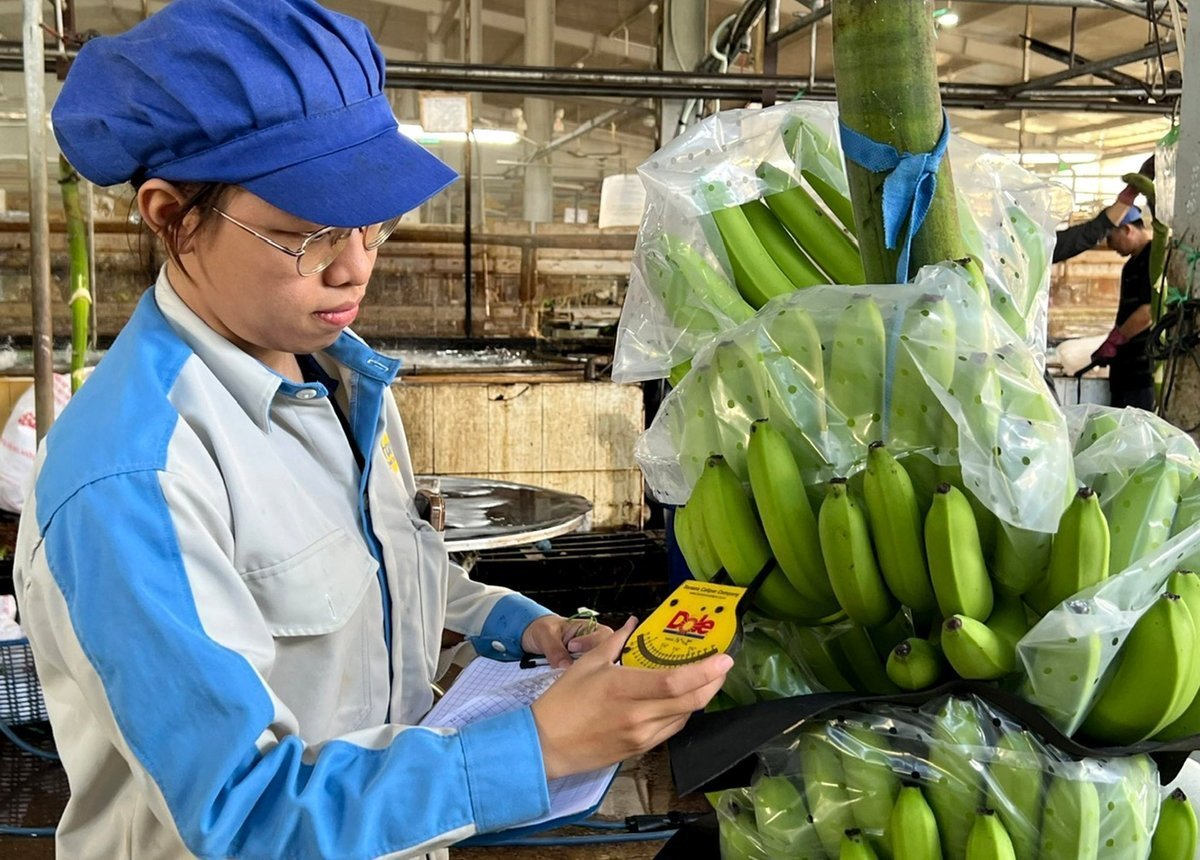November 24, 2025 | 23:49 GMT +7
November 24, 2025 | 23:49 GMT +7
Hotline: 0913.378.918
November 24, 2025 | 23:49 GMT +7
Hotline: 0913.378.918
Vietnam’s fruit and vegetable export value to the end of July this year remained in negative growth at over USD 3.8 billion, down slightly by 0.3% compared to the same period last year.
However, in recent months, exports have surged. Specifically, in July 2025, fruit and vegetable exports reached USD 765 million, up 37% from July 2024. In June 2025, exports were USD 807 million, an increase of 21% year-on-year.
Thanks to sustained growth in these recent months, cumulative exports since the start of the year are steadily emerging from negative growth. By the end of quarter 1, exports had dropped by 9.2%; by quarter 2, the decline had narrowed to 6.7%; and by the end of July, the decline shrank further to just 0.3% as noted above.

Banana exports at Unifarm. Photo: Thanh Son.
The recovery in durian exports is one of the main reasons behind the rebound of Vietnam’s fruit and vegetable exports. Nguyen Thanh Binh, Chairman of the Vietnam Fruit and Vegetable Association (Vinafruit), said that durian exports have returned to normal, no longer facing difficulties like earlier in the year when many Vietnamese durian shipments to China were flagged for cadmium and golden yellow residues.
Beyond durian, exports of other fruits and vegetables such as coconut, passion fruit, and processed mangoes have also seen impressive growth, highlighting the diversity of Vietnam’s export produce. As a result, while fruit and vegetable exports to China have declined significantly since the start of the year, they have grown well in other major markets such as the United States, Japan, Taiwan, the Netherlands, etc. Notably, in the U.S. market, exports of fruit and vegetables increased by 66% in the first seven months of this year, reaching USD 216 million.
Even in the Chinese market, where overall exports in seven months remain negative, exports in July alone surged by 46% year-on-year. The recovery in exports to China over the past two months has significantly contributed to the overall rebound in fruit and vegetable exports.

Fresh coconuts from Vietnam are seeing export growth this year. Photo: Thanh Son.
That said, U.S. retaliatory tariffs are also affecting Vietnam’s fruit and vegetable exports. Nguyen Thanh Binh noted that the 20% retaliatory tax imposed by the U.S. on Vietnamese products increases the cost of Vietnamese produce in that market. At this rate, U.S. consumers may cut back on fruit and vegetable purchases, potentially leading to a steep drop in orders.
The retaliatory tariff undermines Vietnamese produce’s competitiveness against domestically grown produce in U.S. states with climates similar to Vietnam, and against fruits from Latin American countries that enjoy much lower logistics costs when exporting to the U.S. Compared to Southeast Asian countries with lower retaliatory tariffs, Vietnamese produce also faces reduced competitiveness in the U.S. market.
While the U.S. accounts for only 8.2% of Vietnam’s total fruit and vegetable export value in the first seven months of this year, it remains the second largest market after China. Maintaining exports to the U.S. is extremely important for Vietnam’s fruit and vegetable sector, as it is a market with high demand for tropical produce. With its stringent requirements on quality, food safety, packaging and labeling, the U.S. market is a benchmark for product quality, safety, credibility, and compliance capacity of Vietnamese firms.
Therefore, despite some tariff disadvantages, Vietnam’s fruit and vegetable sector will continue to pursue all possible solutions to sustain exports to the U.S., including boosting exports of processed products. According to Nguyen Thanh Binh, processed fruit offers much lower logistics costs and better competitiveness amid retaliatory duties than fresh fruit. Processed items also have longer shelf lives and meet current consumer needs.
Simultaneously, the sector is focusing on maximizing established key markets (China, Japan, South Korea, Europe ...) as well as emerging ones like the Middle East, Africa, and India.
With strong export growth over the past two months, recovery in the Chinese market, stable growth in markets like Japan, Taiwan, the Netherlands, Australia ... and particularly abundant durian harvests from now through November, Mr. Binh is confident that fruit and vegetable exports this year can fully reach the Ministry of Agriculture and Environment’s target of USD 7.6 billion, and potentially approach the USD 8 billion mark.
Translated by Huong Giang

(VAN) An Giang promotes supply-demand connections, standardizes quality and builds value chains, creating a foundation for sustainable bird’s nest development and aiming to expand exports.
/2025/11/24/5339-4-nongnghiep-075331.jpg)
(VAN) Recently, the conference on 'Sustainable Fisheries Linkage Chain - Tilapia for Export' took place in Tien Hai commune, Hung Yen province.
/2025/11/21/4309-2-153400_128.jpg)
(VAN) Green and low-emission rice is paving the way for Vietnamese rice to enter high-end markets, marking the beginning of a transformation journey toward greening and elevating the national rice brand.

(VAN) ‘Right to Win’ outlines a national action plan that shapes a new vision for Viet Nam’s agriculture in an era of renewal and global integration.

(VAN) Lam Dong’s farmed sturgeon output this year is expected to reach 2,300 tons, worth VND 450 billion, affirming the brand’s position on the market.

(VAN) A surge in Ukrainian egg exports, largely driven by soaring sales to the UK over the last few years, has notably pushed up egg prices on the domestic market.

(VAN) The price of Arabica Catimor coffee in Quang Tri is currently at VND 25,000–27,000/kg (fresh cherries), the highest level ever recorded